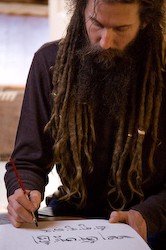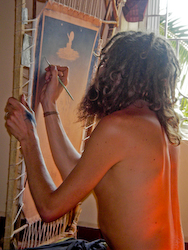 Ben Barta
Ben Barta
In 1992 I began studying thangka painting with Sanje Elliott in Portland, Oregon. Sanje became a guiding force in the realms of painting and dharma practice for me. Through his encouragement and inspiration I traveled to India and Nepal eventually taking refuge there and meeting many wonderful teachers. After several trips to India, I made it to Gonjang Gompa near Darjeeling to study with the master painters Lama Tsondru Sangpo and Rigzin Norbu for several months. During this time much of the focus was on processing mineral and vegetable pigments and dyes, an element of thangka painting which is often very time consuming, expensive and seldom employed in the west. Since that time I have continued dharma practice and painting, completing several commissioned thangkas and a year long retreat.
For most practitioners engaged in tantric deity practice it is very helpful to have a visual image that is correct according to the particular sadhana that one is practicing and at the same time inspiring. One that allows the mind to be deeply at rest and wide awake simultaneously through the clarity and the natural rhythm of form and color. It is with this intention and aspiration and the love and gratitude that has been instilled in me that I attempt to engage each painting.
Karma Ghadri style
 There are different lineages or schools of painting within the Tibetan tradition, each with its variants of color, tone and compositional flavor. The one that I adhere to is called Karma Ghadri or the camp style of the Karma Kagyu school. This refers to the camp culture of the early Karmapa lamas, in which large groups of followers would travel from place to place with them, camping along the way, creating their own customs and traditions. The seventh Karmapa, Chodrak Gyatso is particularly well known for this.
There are different lineages or schools of painting within the Tibetan tradition, each with its variants of color, tone and compositional flavor. The one that I adhere to is called Karma Ghadri or the camp style of the Karma Kagyu school. This refers to the camp culture of the early Karmapa lamas, in which large groups of followers would travel from place to place with them, camping along the way, creating their own customs and traditions. The seventh Karmapa, Chodrak Gyatso is particularly well known for this.
The painting style itself it incorporates elements from three principle countries. The forms were in accordance with Indian standards, the colors and texture, Chinese, and the composition, Tibetan. The painter Namka Tashi (from the court of the Ninth Karmapa) is credited for the birth of this style in the sixteenth century. The most extraordinary and inspiring of the Karma Ghadri painters to me personally however was Situ Panchen (1700-1774) who revived the Karma Ghadri style in the kingdom of Derge and was essentially a Tibetan “renaissance man” who excelled in many areas of his life.
Ben Barta is an amazing painter. I have been teaching Thangka Painting for over 30 years, and I am very happy to say that Ben has developed into the best student who has come into my classes. He also studied with many teachers in India and Nepal and has gathered the essence of the Eastern Tibetan style of painting called Karma Ghadri, and has been able to add his own sense of luminosity to the tradition. Like all great art, one needs to see these paintings in person to appreciate their spiritual value.
I commissioned Ben to paint 2 thangkas for me. I’m amazed at how he brings to the thangka a flawless adherence to the tradition and extraordinary skill. What is even more meaningful is that Ben in painting a thangka immerses himself in genuine meditative presence. The life force residing in the thangka is evidence of that. I have had the honor to meet with the most well known and respected thangka painters of India and Tibet and in my opinion Ben joins the pantheon completely. May his work flourish and benefit all beings.
A thangka is a devotional tool; a device to remind the practitioner. It is not intended to be “art” in the western sense, though I cannot imagine that a Tibetan would not appreciate a pleasing image. I am a westerner, an art collector and a practitioner. Ben created a thangka for me, a westerner who wanted a devotional object, but not just because it was going to be beautiful. I got what I asked for….and also a thing of sublime beauty where the skill and deftness of the artist enhanced the value of the thangka as an aid to my practice.
Ben Barta’s paintings are breath-takingly beautiful. Many current thagkas have bright, cheery, but “loud” colors. Ben’s palette is muted and all the colors have appropriately related values. This requires a very high skill and knowledge of color study. Ben has this. Ben’s respect for each diety comes through in the painting. It is easy to imagine that Ben practices with the deity as he paints. This brings out the inherent quality of the deity and allows a viewer to gain insight just by viewing the painting. The dot technique, a critical part of thangka painting, is so fine in Ben’s work as to be almost imperceptible. This ability requires a stable level of patience, reflecting Ben’s practice of patience. The combination of these qualities is rare in any thangka, all of which are present in Ben’s thangkas. The result is a painting worth far more than the price charged for the painting.
“Ben Barta conducts careful research for each of the thangkas he paints. He seeks out and relies upon the living masters of tantric lineages and the great thangka painters and masterpieces. Ben paints with the specific intent of authentically reviving rare, and nearly lost, subject matter using traditional painting techniques and materials. Thus, with his life’s work, he has supported the continuance of Indian and Tibetan art and culture—and practitioners of meditation everywhere.”
As Resident Lama of Kagyu Changchub Chuling, a Dharma Center for the practice and study of Tibetan Buddhism, I am happy to say I am grateful for Ben Barta’s competent and highly skilled execution of a Lhashi thangka for our three year retreat center. Ben’s artistic gift and his years of Buddhist practice are evident in the quality and the feel of the painting, and is equally apparent in all his work. He is a joy to work with and easy to recommend to others looking for a an inspiring and technically correct painting.